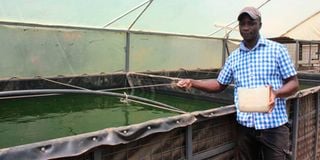Aquaponics pays off for farmer

Charles Makanga feeds fish on his farm in Kimumu, Uasin Gishu County.
What you need to know:
- Charles Makanga, he uses water from his fish farm to irrigate his crops.
- Droppings from his poultry unit help him cut what he spends on fish feeds.
A murram road leads the Seeds of Gold team to a one-acre farm in Kimumu, off the Eldoret–Iten Road in Uasin Gishu County.
Known as Green Pastures Smart Farm, the entity hosts fish, poultry and a variety of crops farmed under the aquaponics system.
Charles Makanga, 49, the owner, says nothing goes to waste under the farming system.
“I use water from the fish pond, which is rich in ammonia, to irrigate my crops on the farm. The model I use is that everything on this farm depends on the other,” says Makanga as he leads the Seeds of Gold team to a greenhouse that hosts eight raised ponds where he rears catfish and tilapia.
It all began in 2012, recalls Makanga. He quit maize and wheat farming due to poor returns to try his hand in aquaculture. Initially, he was keeping the fish in eight earthen ponds but moved them into raised ponds inside the greenhouse.
“The ponds are made up of steel and dam liners. Some 7,200 tilapias are in seven ponds while 150 catfish occupy one. Four of the ponds measure 6 by 5m while the others 4 by 3m,” says Makanga.
Farming inside greenhouse
He went for greenhouses having realised that fish thrives well in warm temperatures.
“When they mature faster at seven months, this cuts my spending on feeds. The colder the temperatures, the more time fish takes to mature,” says the graduate of theology and religion. His poultry unit, located above the pond with catfish, hosts 50 chickens.
“The fish, mainly the catfish, feeds on the birds’ droppings making it cheaper to run the unit,” he explains, adding he feeds the catfish the droppings because they can survive in acidic water unlike tilapia.

Charles Makanga at his fish farm in Kimumu, Uasin Gishu County.
Farming inside the greenhouse, he observes, gives the right environment for algae and planktons to flourish in the ponds giving his fish extra food.
The farmer sells the bulk of the fish directly to hotels and fish mongers at between Sh150 and Sh250 each.
Besides keeping fish, he also rears bees in a project he started in 2014.
“I have 30 hives from which I harvest nine to 13kg of honey after every four months, process and sell at Sh800 a kilo.”
High cost of feeds
His farm serves as a demonstration facility where he charges farmers who visit Sh1,000 per day, getting an average of five visitors every week.
Makanga also grows Hass avocados, passion fruits, arrowroots and tomatoes that he irrigates with water from the ponds. He also keeps dairy goats as well as breeds dogs for security purposes.
“My advice to farmers is to start small and expand gradually. If you start big, you might encounter bigger problems and get discouraged,” says the farmer, noting high cost of feeds and lack of skilled farm workers as some of his challenges.
Charles Mwaniki, the assistant director of fisheries at the Uasin Gishu county government, says tilapia and catfish have faster growth when kept in warmer environments like inside greenhouses, especially in the region which experiences very cold weather sometimes.
Demand for fish has gone up in the county, according to him, adding that farmers practising aquaculture have great advantage.
“The daily consumption of fish in Uasin Gishu stands at three tonnes yet we don’t produce enough. Most of the fish comes from Uganda, some from lakes Turkana and Victoria,” says Mwaniki.





